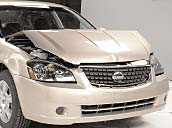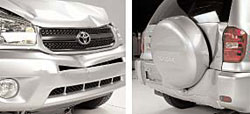|
The High
Cost of Mismatched Bumpers
Low-speed
front-into-rear crashes occur frequently in urban traffic,
and the vehicles often sustain expensive damage. Bumpers
can reduce this damage, but only if they line up so the
initial contact upon impact is bumper to bumper. Then the
bumpers on the colliding vehicles absorb the crash energy,
keeping damage away from expensive sheet metal, lights,
and other components.
Car
bumpers are required by a federal standard to match up reasonably
well. However, these requirements do not apply to SUVs,
and some of these vehicles don't even have bumpers. So mismatches
in crashes are increasing, and the resulting repair costs
from low-speed collisions are escalating. The Institute's
new series of 10 mph front-into-rear crash tests demonstrates
this mismatch problem.
Car-into-SUV
and SUV-into-car crash tests
The Institute's tests
involved five pairs of vehicles, each pair composed of a
car and a midsize SUV from the same manufacturer. The pairs
included a Ford Taurus and Explorer, a Chevrolet Malibu
and TrailBlazer, a Dodge Stratus and Jeep Grand Cherokee
(both DaimlerChrysler products), a Nissan Altima and Murano,
and a Volvo S40 and XC90.
"We
paired vehicles from a single manufacturer because we thought
that, at a minimum, automakers should be paying attention
to the compatibility of the bumpers across their own fleets,"
Institute chief operating officer Adrian Lund explains.
In
the tests, a car going 10 mph struck the back of its paired
SUV, which was stopped. Then the configuration was reversed,
with the SUV striking the back of its paired car. Results
of these low-speed impacts varied widely, from a total of
about $1,250 damage in one test to more than $6,000 damage
to the paired vehicles in two other tests.
|
DAMAGE
REPAIR COSTS, 10 MPH FRONT-INTO-REAR CRASH TESTS
|
| CAR
INTO SUV |
Car
damage |
SUV
damage |
Total
damage |
| Ford
Taurus into Explorer |
$1,784 |
$824 |
$2,608 |
| Chevrolet
Malibu into TrailBlazer |
$3,163 |
$937 |
$4,100 |
| Dodge
Stratus into Jeep Grand Cherokee |
$3,256 |
$1,279 |
$4,535 |
| Nissan
Altima into Murano |
$4,507 |
$1,188 |
$5,695 |
| Volvo
S40 into XC90 |
$4,984 |
$1,096 |
$6,080 |
|
|
|
|
| SUV
INTO CAR |
SUV
damage |
Car
damage |
Total
damage |
| Ford
Explorer into Taurus |
$701 |
$555 |
$1,256 |
| Volvo
XC90 into S40 |
$1,695 |
$2,361 |
$4,056 |
| Chevrolet
TrailBlazer into Malibu |
$1,851 |
$2,316 |
$4,167 |
| Nissan
Murano into Altima |
$2,517 |
$2,485 |
$5,002 |
| Jeep
Grand Cherokee into Dodge Stratus |
$2,848 |
$3,281 |
$6,129 |
|
|
|
|
Note:
Except for the Altima, cars and SUVs are 2004 models;
Altima is a 2005.
Repair costs reflect July 2004 parts and labor prices. |
In some cases, the low-speed crash damage included major leaks from broken radiators. In real-world collisions like these, the motorists couldn't even drive away. If they did, their vehicles could overheat and the engines could be permanently damaged. So in addition to paying for costly repairs, the drivers would face the aggravation of having to get their vehicles towed.
Less damage to Fords
In both car-into-SUV and SUV-into-car tests, the vehicles with the lowest repair costs, by far, were the Fords. This is almost entirely because the bumpers on the two Fords match up better than the bumpers on the other vehicles. Virtually none of the damage from the Explorer-into-Taurus impact was apparent during a cursory inspection after the crash. The damage was hidden underneath the plastic bumper covers.
 |
MATCHING BUMPERS ON FORDS
In a 10 mph front-into-rear crash test, damage was less (total $1,256) than to other pairs of vehicles in the same test. |
 |
MISMATCHED BUMPERS ON DAIMLERCHRYSLERS
Bumper mismatch is the main reason damage repair costs exceeded $6,000 in the same 10 mph front-into-rear crash test. |
| |
 |
| This Nissan Altima sustained a total of $4,507 damage when it struck the back of a Nissan Murano at 10 mph. |
| |
 |
| Damage to striking RAV4: $4,380; damage to struck RAV4: $3,230
When a Toyota RAV4 (left) hit the back of another RAV4 (right) at 10 mph, more total damage occurred than in any of the car-into-SUV or SUV-into-car tests. This is mainly because the RAV4, a small SUV, doesn't have a rear bumper, and the spare tire on the back exacerbated damage to both vehicles. |
|
"It's likely that motorists in collisions like this would assume there wasn't any damage," Lund says. "An owner would have to go to a repair shop for disassembly of the bumper system to determine whether damage had occurred and how much. So in many cases the damage would go undetected and unrepaired. This shouldn't pose a safety problem but could worsen the damage in any subsequent low-speed collision."
Pattern of damage
The other pairs sustained more damage than the Fords, mostly because their bumpers don't line up. The bumpers on some vehicle pairs completely bypassed each other in the tests.
"This was the pattern," Lund points out. "When there was underride and override between the car and SUV bumpers, we saw a lot more expensive repair damage than most people would associate with a 10 mph impact. Bumps at this speed involving Volvos and DaimlerChryslers produced more than $6,000 damage."
Most of the repair costs from these tests weren't because a heavy SUV inflicted damage on a lighter car. The SUVs also sustained expensive damage. Even when one SUV hit another SUV, the damage was costly.
Toyota RAV4 strikes RAV4:
The Institute conducted another 10 mph crash test to show that the problem isn't confined to crashes between cars and SUVs. In this impact, the front of a Toyota RAV4, a small SUV, hit the back of another RAV4, producing more damage than in any of the car-into-SUV or SUV-into-car crashes.
"When one RAV4 struck the other, it didn't engage the rear bumper because this SUV doesn't have a rear bumper. Instead the striking RAV4 hit the spare tire mounted on the tailgate," Lund says. "This spare tire was the 'antibumper.' It didn't absorb any energy. It didn't prevent any damage. In fact, it caused most of the damage to both vehicles. The spare damaged the hood and grille of the striking RAV4. It also crushed the tailgate on the struck RAV4."
Rules apply to cars only, not SUVs
A federal standard specifies a zone on cars for bumper protection extending from 16 to 20 inches off the ground. This means car bumpers line up reasonably well. When two cars collide at low speeds, the bumpers are more likely to engage. Then, they have a chance to absorb energy and prevent damage. But no such bumper requirements apply to larger vehicles such as SUVs, pickup trucks, or minivans, so these vehicles often have flimsier bumpers than cars. The heights of their bumpers often are different from the mandated heights for car bumpers.
As SUVs have proliferated in recent years, so has bumper mismatch. Now SUVs account for about one of every four passenger vehicles sold in the United States. Together pickups and SUVs account for almost half.
Change the federal bumper rules
Because SUVs don't have to meet the bumper requirements established for cars, automakers are free to equip these vehicles with minimal bumpers or no bumper at all, like the rear of the Toyota RAV4. If an SUV does have bumpers, they aren't required to line up with those on cars.
"The federal rules should be changed to make SUVs and cars more compatible. The manufacturers already are working on this for high-speed collisions, and they ought to be doing it for low-speed impacts like these tests. SUVs can have the same utility they do today and still be equipped with decent bumper systems that extend down to where they match up with those on cars," Lund says. "Until then, motorists who bump into mismatched vehicles, even at very low speeds, will have no choice but to open their wallets."
Source: Insurance Institute for Highway Safety
|